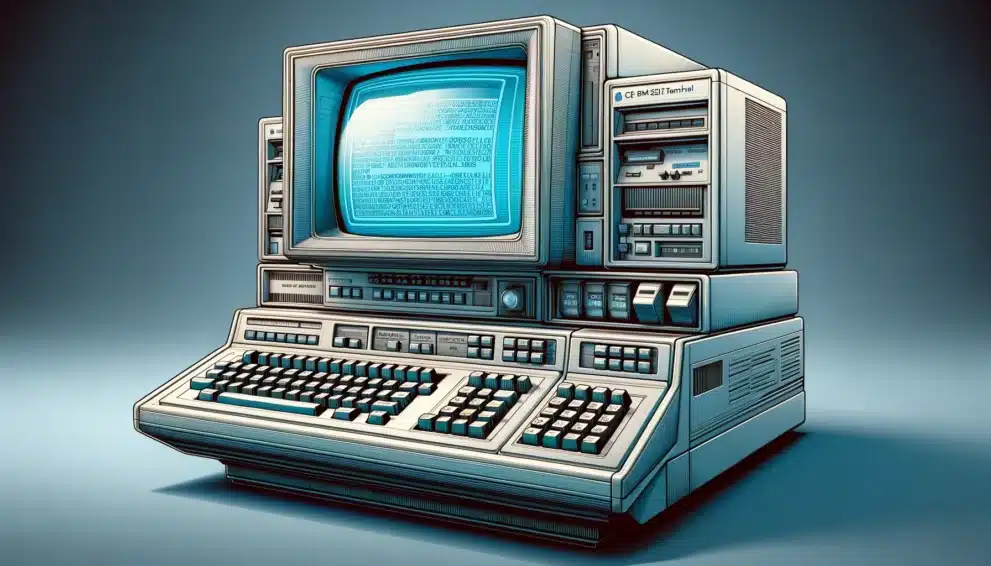
The IBM 5251 is part of the IBM 5250 family of block-oriented terminals, primarily known for its association with midrange computer systems like the IBM System/34, which was introduced in 1977. The 5250 series, including the 5251, was designed to connect to a range of IBM systems including the later System/36, System/38, and the IBM AS/400 systems, as well as IBM Power Systems running IBM i. The 5251 terminal is recognized for its robust build and was often used in conjunction with IBM’s midrange computer systems for various data processing tasks. It’s also noted for its distinctive ‘beamspring’ keyboard, a feature that provided a unique typing experience and contributed to its popularity during its time of use.
The IBM 5251 terminal was primarily used during the late 1970s and throughout the 1980s. It was introduced as part of the IBM 5250 family around 1977, coinciding with the launch of the IBM System/34 midrange computer. The terminal remained in use into the 1980s, often connected to subsequent IBM midrange systems such as the System/36 and System/38, and later the IBM AS/400 systems. The 5251 and its associated systems were prevalent in business environments, particularly for tasks like data entry, inventory management, and other forms of transaction processing, until they were gradually replaced by more advanced systems and PC-based solutions.
The IBM 5251 terminal was widely used by a diverse array of businesses and organizations that depended on IBM’s midrange computer systems for their daily operations. Manufacturing companies utilized it for overseeing inventory and production schedules, while retail businesses employed it for managing point of sale transactions and inventory control. Financial institutions, including banks and insurance companies, relied on it for account management and transaction processing. Educational institutions found it valuable for administrative tasks and managing student records, and government agencies used it for various administrative, planning, and data management tasks. The robustness of the IBM 5251 terminal and IBM’s extensive support made it a prevalent tool in many professional environments during its time.
Finding an IBM 5251 terminal today would likely involve exploring niche markets for vintage computing equipment. Online auction sites like eBay or specialty forums dedicated to vintage computer collectors are potential sources where such items might appear. Additionally, you might find luck through networking within communities that appreciate and preserve legacy computing systems, as members sometimes trade or sell their own equipment. While these terminals are no longer commercially produced or widely available, enthusiasts and collectors often know the best channels for acquiring such unique and historical pieces of technology.
The IBM 5251 terminal, part of the IBM 5250 series, faced competition from various other terminal and computer systems that were prevalent in the same era. Notable among these were terminal solutions from companies like Digital Equipment Corporation (DEC), which offered the VT series terminals, and Hewlett-Packard (HP). These competitors provided similar functionality, catering to businesses and organizations in need of data processing and management solutions. The competition was not just in terms of hardware, but also in the broader ecosystem of midrange computing, where different manufacturers offered their own unique combinations of terminals, servers, and software. Each of these systems had its own set of strengths, and the choice for businesses often depended on specific needs, existing infrastructure, and brand loyalty.
Over time, the IBM 5251 terminal and similar devices were gradually replaced by more advanced personal computers and networked systems. The evolution of technology brought in powerful, user-friendly PCs that offered greater versatility and connectivity, shifting the computing paradigm from centralized mainframe and midrange systems to distributed computing. Operating systems like Microsoft Windows and various forms of Unix/Linux provided robust platforms for a wide range of business applications. These newer systems offered not just improved computing power and flexibility but also a more intuitive graphical user interface (GUI), making them accessible to a broader user base. The transition was part of the broader IT industry’s shift towards more integrated, networked, and user-centric computing solutions.



 Share
Share Tweet
Tweet Share
Share




Comment